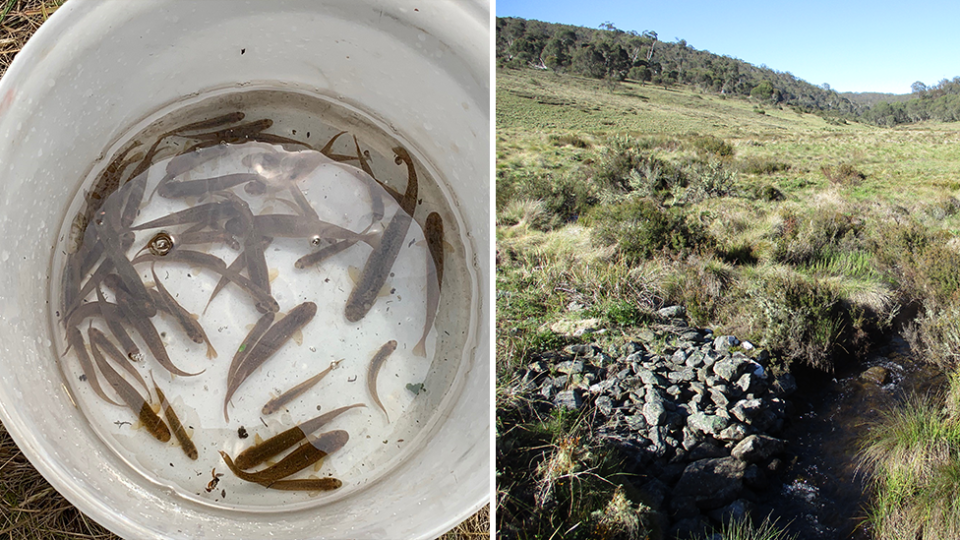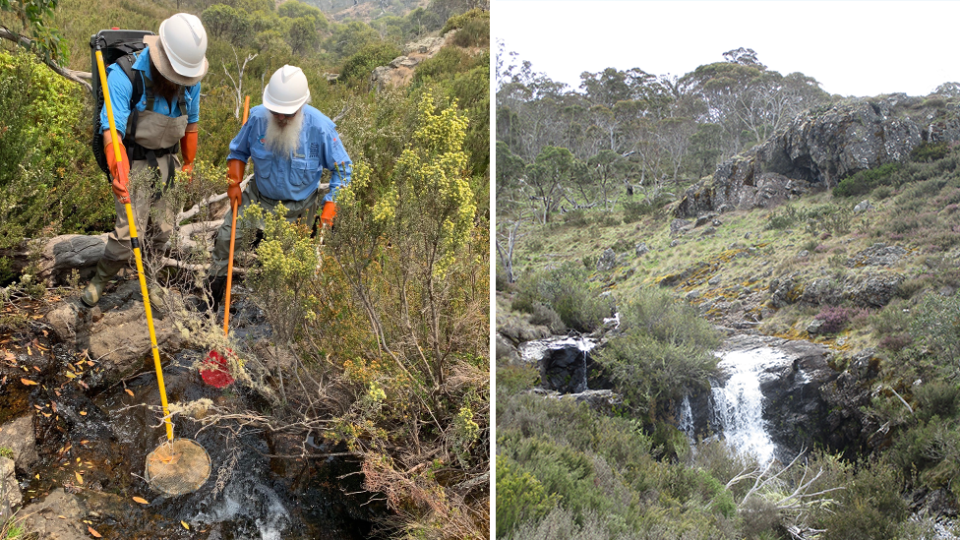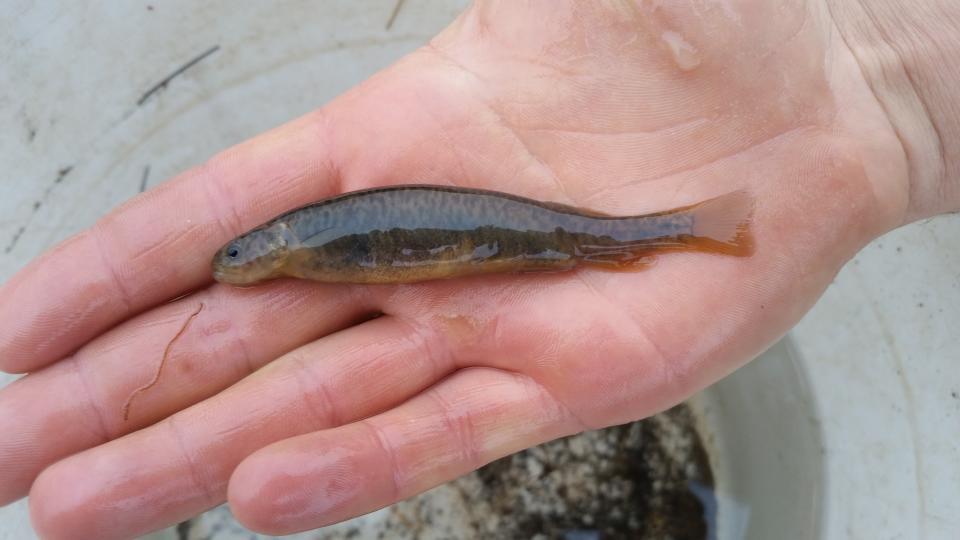'Game is over': Extinction fears for species living in tiny stretch of Aussie river
A threatened species, surviving in a tiny pocket of a NSW national park, could be pushed to extinction by an invasive climbing fish if a newly approved construction project goes ahead - an expert warns.
The race is on to save the stocky galaxias, a tiny native fish first described in 2014, and restricted to just 3km of the Tantangara Creek in the Kosciusko National Park, 360km south of Sydney.
Stocky galaxias’ last remaining stronghold is protected by a waterfall which works as a barrier, holding back predatory fish which live in the river such as trout.

On Thursday, the Snowy 2.0 construction project, which aims to provide power capacity for 500,000 homes during peak periods, was given the green light by the NSW government.
Planning minister Rob Stokes said the plan will create 2,000 jobs during the construction phase, and adhere to strict environmental conditions.
“The projects approval also requires Snowy Hydro to invest almost $100 million for biodiversity and environmental offsets to protect threatened species and deliver long-term conservation and recreational benefits for the Kosciuszko National Park,” Mr Stokes said.
‘It can climb waterfalls’: threat of introduced fish
The project will connect the Tantangara Reservoir to the Talbingo Reservoir, which is home to an introduced predatory fish with a similar name to its threatened cousin - the climbing galaxias.
Associate Professor Mark Lintermans from the University of Canberra told Yahoo News Australia if the climbing galaxias enters Tantangara Creek via the reservoir, it will be able to scale the waterfall protecting the stocky galaxias.
“It’s called the climbing galaxias for obvious reasons - because it can climb, it can climb waterfalls without even thinking about it,” he said.
"So the barrier that has protected stocky galaxias will disappear, and so the stocky galaxias will disappear.
“The stream that stocky galaxias are in is really small, it’s only a metre wide and 10cm deep, so it’s not like there’s a huge amount of room.
“Climbing galaxias with compete with and prey upon stocky galaxias.”

‘If climbing galaxias gets in, then the game is over’
A condition of the plan is that Snowy Hydro invest millions of dollars to help protect stocky galaxias and the endangered Macquarie Perch.
A barrier will be constructed on top of the waterfall by Snowy 2.0 to hold back the spread of climbing galaxias, however Assoc Prof Lintermans has called the planned protection measures “woefully inadequate”.
“If it fails, even if it only fails for a bit and climbing galaxias gets in, then the game is over,” he said.
“They’re going to build this barrier on top of the waterfall, so it only protects this existing population, but as a critically endangered species, we want to recover the species.
“So we want to introduce it to some other streams nearby, so if there’s a drought or a bushfire nearby all your eggs aren’t in one basket.
“By building this supposed barrier on top of the waterfall, it means that all other potential areas where we might introduce it will become infested with climbing galaxias, severely compromising the long term future of the species.”

Claims about fish disappearing ‘incorrect’
Snowy Hydro CEO Phil Broad told Yahoo News Australia in a statement that claims about Snowy 2.0’s impact on threatened fish species are “incorrect”.
“Snowy Hydro has been operating responsibly in the National Park for more than 70 years,” he said.
“During the environmental assessment process for Snowy 2.0, Snowy Hydro worked with a number of independent scientific and technical experts to determine that while pest fish could potentially be moved during operations from Talbingo to Tantangara Reservoir, the risk of pest fish establishing a new population or getting further into the rivers where threatened fish are present, is considered very unlikely.”
Mr Broad said pest fish would have to overcome a series of “significant obstacles” in order to impact on threatened species.
This would include entering a tunnel deep in the reservoir, surviving compression and decompression, then navigating blade turbines spinning at 500rpm.
According to Mr Broad, the fish would then have to enter Tantangara in numbers significant enough to breed, and then bypass 0.5mm fine mesh netting which will be installed at all outlets from the reservoir at a cost of $25 million.
Plan to raise threatened fish in captivity
Should plan fail, Snowy Hydro 2.0 is investing a further $5 million in a program to breed stocky galaxias and Macquarie perch in captivity - a feat that has never been achieved before.
National Parks Association executive director Gary Dunnett told Yahoo News Australia he believes the Kosciusko wilderness is no place for an industrial development such as Snowy 2.0 and that the habitat should not be disturbed.
'Mentally and physically draining': Race to save survivors after mass bird deaths
'It's devastating': Concern for threatened animal amid state's trapping plan
'Shredded': Call for rethink of barbed wire fencing after horrendous deaths
“If we’re at a point where governments think that the way to protect endangered species is to stick them in an aquarium, we’ve well and truly lost the plot,” he said.
“In the context of the summer that we’ve just been through, where we know that we've got literally dozens of species which sit at the brink, to have an industrial development in a national park with such cataclysmic environmental consequences just beggars belief.
“It sets an appalling precedent, and one that is a terrible, terrible legacy for this government.”
The project will now be considered by the NSW independent planning commission and requires federal environmental approval before going ahead.
Do you have a story tip? Email: newsroomau@yahoonews.com.
You can also follow us on Facebook, Instagram and Twitter and download the Yahoo News app from the App Store or Google Play.




